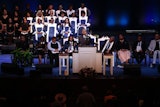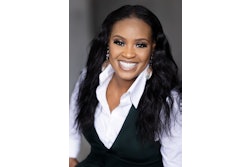Making the Past Present
The founding director of the Smithsonian’s National Museum of African
American History and Culture is at work to make his vision a reality
By B. Denise Hawkins
WASHINGTON
Historian Lonnie G. Bunch III talks often about “the ancestors.” On the job since July, the founding director of the Smithsonian’s National Museum of African American History and Culture knows that the “eyes of the world” are trained on him now. But he says knowing that “the eyes of the ancestors” are looking down on him is what gives him a sense of honor and feelings of both trepidation and humility.
Since discovering one of those ancestors, he hasn’t let her go. In fact, she’s taken up residence in his office. Her face is haggard. Her body is small. She is nameless. The black-and-white 1880s photograph is of a slave making her way from the fields. Her framed image is one of Bunch’s treasures.
“This woman, clearly a slave … is carrying a hoe that’s bigger than she is, and a basket that’s large. And if you look at the picture closely, her knuckles are swollen, the dress is tattered and yet she’s striving forward,” Bunch says. “Whenever I’m ready to quit, I look at that picture and say, if she did it, so can I. That’s what history does to me. History is really the greatest inspiration that we can have.”
Bunch’s grandfather and parents, all graduates from historically Black Shaw College (now Shaw University), provided his early lessons in perseverance. His personal journey began in Belleville, N.J., as did his love of history and stories. History was all over his house, Bunch remembers. It filled the backyard when company came for barbeques. It was in the kitchen. The past was always present.
“In all of our lives there are places where you hear people telling stories or sharing history. I loved the notion of hearing those stories — what Jackie Robinson meant to somebody, not what he did as a baseball player,” Bunch says. “That history and those stories made me realize that what I wanted to do was to help people to remember.”
Bunch, a former professor of history at the University of Massachusetts Dartmouth, describes himself as “a drum major for African-American culture.” He will be 62 when the doors of the new museum swing open. For now, he’s writing, talking and instilling those he meets with excitement about a museum that at this point exists only in his mind.
“The day I was hired, this museum existed,” he says. For the next year, he and a handful of staff will be figuring out how to satisfy their many constituents and crafting a vision for the nation’s largest African-American history museum.
A national museum with no address, Bunch says, is a technicality. “I don’t want people saying to me, ‘I’ll see you in 10 years when it is a reality.’ It is a reality now. I just don’t have a building yet.” At press time, the Smithsonian board of regents was expected to select a site during its scheduled meeting in late January. Congress asked the
regents to consider four sites for the first major African-American history museum. One is the Smithsonian’s Arts and Industries Building on the Mall; a second is opposite the Washington Monument. The others are a short distance from the Mall. President Bush has weighed in, saying he favors a location on the Mall.
“One of Us”
Picking Bunch for the new museum post was “very appropriate and not unexpected,” says Fath Davis Ruffins who’s been curator of African American History and Culture in the Smithsonian’s American History Museum for 25 years. But “His is a daunting task.” Ruffins, author of the book Finding Our Story in the History of the Nation: A Pictorial Guide to Black History and Art in America’s Museums to be published this year by Smithsonian Institution Press, is hopeful that Bunch will be able to stay the course and see the museum over the next 10 years, a conservative timetable for building a museum of this stature on the National Mall. By comparison, the U.S. Holocaust Memorial Museum took 14 years to open. The Smithsonian’s National Museum of the American Indian took 15 years before it opened in 2004.
Although Congress authorized $3.9 million in start-up financing in 2003, the new museum will still require an estimated $300 million in private and public funds before it’s completed. Bunch says he’s counting on a strong and growing Black middle class for support and hopes to capitalize on those with a “pent-up need” to see Black America’s story told.
“This is going to be a great museum. It’s also going to be a place of reconciliation and healing,” he says. “It’s going to be a place that gives people a useful past to help shape their lives today.”
But this will be unlike any other African-American museum. Bunch is heading the only national museum devoted exclusively to the documentation of African-American life, art, history and culture. With that distinction comes the Smithsonian’s world-renowned reputation and a new 17-member council that includes talk show host and entertainment mogul Oprah Winfrey; Robert L. Johnson, founder of Black Entertainment Television; Richard Parsons, CEO of AOL-Time Warner; Kenneth I. Chenault, CEO of American Express; H. Patrick Swygert, president of Howard University; and Dr. Michael L. Lomax, president and CEO of the United Negro College Fund. Eminent historian and author Dr. John Hope Franklin is also a part of the museum’s scholarly braintrust.
Bunch is familiar with the special mandates of Black museums. From 1983 to 1989, he worked at the California African American Museum in Los Angeles, where he was curator of history and program manager. Looking back, Bunch says the California museum is where he learned to do it all.
“Even though it was a small, state-funded museum, it really gave me the opportunity to jump into the big pond and see if I could swim,” he says. As a result, “I learned everything. The Smithsonian taught me how to be a scholar and California taught me how to curate exhibitions, how to work with communities, how to care about educators, how to work with teachers and how to handle politicians.”
Bunch knows the inner workings of the Smithsonian well. He left California to become a curator and administrator at the Smithsonian’s National Museum of American History. He led the team that produced “American Presidency: A Glorious Burden,” a sprawling permanent exhibition that showed how the pressures of the office shaped the occupants of the White House. It went from idea to opening in eight months, an almost unheard of turnaround time by museum standards. For six years, as the museum’s associate director for curatorial affairs, Bunch managed 14 departments and 150 people. He left the Smithsonian in 2000 for the Chicago Historical Society, where he made history as the first African-American president in the institution’s 149-year history.
“Bunch is one of us,” says Dr. Lawrence J. Pijeaux Jr., president of the Association of African American Museums, a professional membership organization of about 100 Black museums and cultural institutions. He’s known Bunch professionally for more than a decade. Pijeaux, who is also president and CEO of the Birmingham Civil Rights Institute in Alabama, says, “Lonnie is the right person for the job. He knows how to galvanize support among both Blacks and Whites. He’s been a part of both museum worlds.”
Pijeaux has no fear that the Smithsonian’s mammoth new cultural house will eclipse his own organization. Rather, “as he is successful, I know that it will spill over to those of us in the African-American museum community. The new museum will be a catalyst,” he says.
The Museum Takes Shape Bunch has been on the job as the museum’s founding director for less than a year, but he’s spent the last six months working to make the long-awaited museum real for its eventual visitors. The museum’s program calendar is already jammed with concerts and traveling exhibits the museum will host this year. There will be a concert series showcasing folk, sacred, traditional and contemporary music, including jazz and hip-hop. He’s planning to celebrate the musical contributions of Louisiana and the Gulf states hit by Katrina and to launch a traveling exhibit featuring the work of Black photographers.
“We’re looking for things that will speak volumes about Black history,” says Bunch, who’s eager to launch a “Save Our African-American Treasures” campaign and showcase the “30-40 years of really good scholarship on issues of race and African-American culture.”
The treasures he’s looking for “might be something as simple as shoes that somebody wore on the march to Selma, the heels all worn,” he says. Or perhaps pieces of tarp that shielded desperate Hurricane Katrina victims or the homemade signs for help they waved to the world.
What some of these artifacts say to Bunch is that “despite what little we have, we sacrificed it all to change America.”
© Copyright 2005 by DiverseEducation.com


















